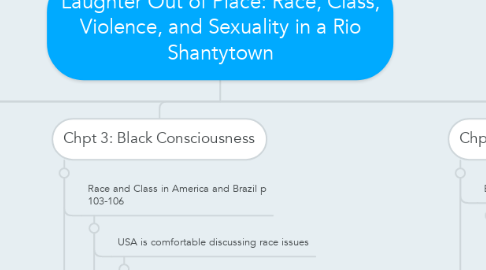
1. Theoretical Issues
1.1. Sahlins vs Foucault
1.1.1. Foucault = power is everywhere
1.1.2. Sahlins= culture is not equal to power
1.2. Postmodern caution against "giving voices to the powerless"
2. Ethnographic Objectives
2.1. Significance of humor and suffering
2.1.1. Source of humor is sorrow
2.2. Identify sources of data
2.3. Explain these foundations of analysis
2.3.1. I. Effect of power
2.3.1.1. Lack of power=illness, hunger, violence, etc
2.3.2. II. How power is experienced by poor
2.3.2.1. Formation of power in slums is based on history of class differences
2.3.3. III. Class, violence, family, history, sexuality
2.4. Outline main historical events
2.5. Narrate how she came to study in Brazil
3. Research Methods
3.1. Interviews
3.2. Observations
3.3. Protecting Confidentiality
3.4. Oral Culture
3.5. Political and economic history
4. Chpt 2: Lives of Domestic Workers
4.1. Struggle to earn a living wage p 61-68
4.1.1. Usually earn 1 minimum salary
4.1.2. Is typical to be payed only daily
4.1.3. 14 hr workdays
4.1.4. Public transport eats at earnings
4.2. Poverty in Brazil and Rio de Janeiro p 69
4.2.1. Economy is in decline
4.2.2. Rio de Janeiro is the most unequally distributed of income of any metropolitan area in Brazil
4.3. Power Relations p 88-90
4.3.1. Masses are seen as less civilized
4.3.2. Consumer culture caters to middle and upper classes
4.3.3. Europhile redivision of public spaces
4.3.4. Euphemizing Discourse
4.3.4.1. Privileged classes convince themselves patronage is better for servants than lives on the "outside"
4.3.4.2. Longevity of careers makes patrons think system is healthy
5. Chpt 3: Black Consciousness
5.1. Race and Class in America and Brazil p 103-106
5.1.1. USA is comfortable discussing race issues
5.1.1.1. Poverty is race related, not class
5.1.2. Brazil is not comfortable
5.1.2.1. No civil rights movements
5.1.2.1.1. Because issues are social, and not legally related
5.1.2.2. Poverty is class problem, not race
5.2. Escaping poverty
5.2.1. Marry a coroa p 122
5.2.1.1. Men and women bring different capital
5.2.1.1.1. Man's attractiveness = economic standings
5.2.1.1.2. Woman's attractiveness = beauty
5.2.1.2. A coroa is usually an older, white, rich male
5.2.2. Representations and Commodifications of Black Bodies p 111-115
5.2.2.1. Azevedo see's them as tropical, sensual, and untamed
5.2.2.2. 4 American Sterotypes
5.2.2.2.1. Jezebel, Mammy, Welfare Mother, and Matriarch
6. Chpt 4: No Time for Childhood
6.1. Everyday life of children p 156-165
6.1.1. Many dropped out of school
6.1.2. Gang life is common
6.1.3. Must comply with house rules
6.1.4. Begin day with chores
6.2. The killing streets 146
6.2.1. Growing violence on the streets
6.2.2. Homeless children are targeted and killed by police
6.3. "Protection"168-170
6.3.1. Sometimes there are no child beatings by gangs
6.3.1.1. Provides false positive images to children of gang life
7. Chpt 5: State Terror, Gangs, and Everyday Violence in Rio de Janeiro
7.1. Crime and Violence in Rio p 175-180
7.1.1. Gangs
7.1.1.1. Difficult to avoid
7.1.1.2. Offer sense of identity
7.1.1.3. Fueled by elite drug consumption
7.2. Solution of Private Matters p 190
7.2.1. Unaddressed by authorities
7.2.2. Gangs are the justice system
7.3. Disdain for police p 204-205
7.3.1. Very corrupted
7.4. Criminalization of the poor p 205- 209
7.4.1. Rule of law belongs to elite
7.4.2. No outrage of death squads
7.4.2.1. Poor are of no concern
8. Chpt 6: Partial Truths and Carnivalization of Desire
8.1. Carnivalization of Desire p 231-237
8.1.1. Bodily liberation is a part of Brazil
8.1.1.1. Done through body language, dress, flirtation, dancing
8.1.2. America vs Brazil
8.1.2.1. Brazilian women appreciate flirtation and attention from men
8.1.2.2. In Brazil, being ignored is punisment
8.1.2.2.1. American women prefer being ignored
8.2. Ethnography: Local sex culture p 236-242
8.2.1. Symbols
8.2.1.1. Comer vs Dar
8.2.1.1.1. Comer means to eat, and is associated with men's sexual appetites
8.2.1.1.2. Dar means to give, and relates to the idea that women give themselves
8.2.2. Gloria
8.2.2.1. She had 2 complaints of men: Men are inadequate economic providers and are not to be trusted in terms of fidelity
8.2.3. Soneca
8.2.3.1. She is prideful of conquering her neighbor in an affair
8.2.3.1.1. Her situation asks "Whose eating who?"
8.2.4. Women chose to be with abusers with "potential"
8.3. Home protection p 250-251
8.3.1. Filomena ran away and was almost taken advantage of
8.3.1.1. She was not surprised as she gave the impression of living on the streets
8.3.2. She internalized the sense of being unprotected outside of the home
9. Chpt 7: Rape
9.1. Gloria's Story p 262-268
9.1.1. Her home was invaded, and her 2 daughters were rapes
9.1.2. Anita was not a virgin and tried to act like Claudia to hide this fact
9.1.2.1. She later found out she was pregnant by her boyfriend and tried to use the rape to cover it up
9.1.3. Everyone dealt with the situation by laughing, which Goldstein has noted that "black humor" is common for these dark situations
